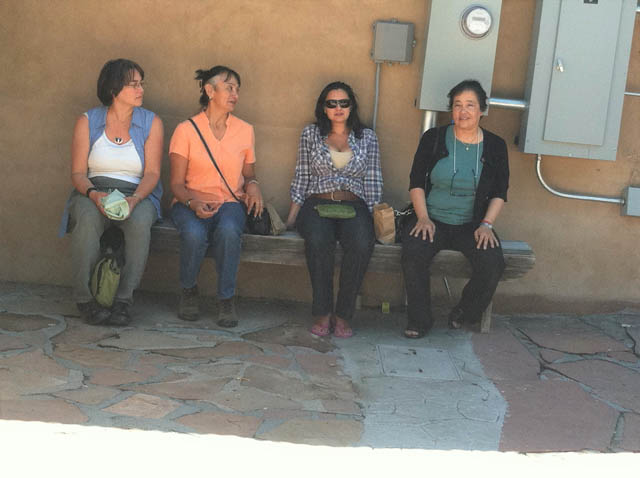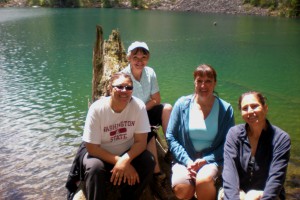Safety for People of Color to Embrace Dharma
Written by: Tuere Sala

A gathering at the end of a People of Color retreat in New Mexico, in 2011. From left to right, Caerdwin Torres, Fransing Daisy, Ursula Tsosie and Bonnie Duran.
To appreciate the message in this article, about the inclusive approach needed to share the dharma with people of color, I invite you into a short meditation.
Imagine you want to learn how to meditate. You’ve heard it has calming benefits and promotes a more conscientious life. You have been searching for something that will help you defuse your growing stress level and quiet your scattered mind. You want a sense of well-being and happiness. Although you are apprehensive, and maybe even a little suspicious, you want to give meditation a try. You decide to attend a six-week beginner’s class.
Now, close your eyes and imagine that when you walk into the room the first thing you notice is everyone in the room is African American. There are about 100 people in the room. Some are dressed in suits, some in casual clothes. Some are older than you. Some are younger than you. They are both men and women. They have dreads, braids, afros, short cuts, curly hair and long straight hair. Their skin tones range from deep black, brown, caramel and tan. How many in that room look like you?
Sense into your body as you contemplate beginning a practice you don’t understand and are not sure you trust, in a room filled with people who are very different from you. Notice your thoughts and be honest with yourself – how long will you stay? Will you even stay for the first class? If you stay for that first class, will you come back for the remaining five?

People of Color students on a day hike, a community-building exercise, in the summer 2011. From left to right are Tuere Sala, Fransing Daisy, Debbie Ruiz and Teresa Brownwolf.
This sense of being surrounded by strangers, when you most need to feel safe, is how it is for most African Americans, or other people of color, encountering Buddhist teachings in the West for the first time.
I am an African American woman who has been practicing Insight Meditation for over 20 years, and I faced that paradox in nearly every meditation room I walked into when I initially started practicing.
I have been an active member of Seattle Insight Meditation Society (SIMS) for 11 years. It is a sangha of more than 200 people, most of them white, who meet weekly in a large community room under St. Mark’s Cathedral, on Seattle’s Capitol Hill.
For many years I was the only African American attending SIMS. Week after week I continued to come back to sit even though no one looked like me. I did so because I was inspired by the dharma and the liberation it brings to all who seek its wisdom. Most people of color face this same paradox with Western insight practice. Over the years, I have watched many people of color attend one sit at SIMS and never return. I longed for a way to increase the diversity of SIMS.
I shared my longing with Bonnie Duran, a Native American woman who is an active member of SIMS. Duran, who has studied with Western and Tibetan dharma teachers, serves Seattle Insight Meditation Society as a local dharma leader, is a graduate of the Spirit Rock Community Dharma Leader program, and is currently in the teacher training program.
By the spring of 2011 we offered our first six-week People of Color Beginner’s Class. We now offer the class twice a year, in the spring and fall, and 37 people have attended the three classes we have so far offered.
People attending come from a wide range of backgrounds, cultures and ethnicities, some with previous meditation experience, most with none. I recently asked them why they came to this particular beginner’s class and their near-unanimous response was the sense of safety.
They were not talking about physical safety but rather about cultural safety. This is the kind of safety that allows you to be yourself around others, and not have to explain yourself and worry you are being looked at through the lens of some stereotype. In other words, they wanted a place to practice where their experience would be about being a normal, vulnerable, doubting beginner and not about race or ethnicity.
At first glance it may seem awkward that someone would attend a separate group for people of color, so that race or ethnicity would not be an issue. It might seem that having a separate group creates a race or ethnicity issue before the person starts practicing, but if you will hold that awkwardness I believe you will understand it better by the end of the article.
The class is one of the many beginner’s classes sponsored by SIMS and is taught along the same theme. Generally we begin with a sitting, give instructions on the week’s object of meditation, spend time in walking meditation, share a dharma talk on the week’s object of meditation and close with a question and answer period. Each week the students leave with homework that can be found on the SIMS website.
Week one is about building sangha and exploring what people want to get out of meditation. Bonnie and I explore the difficulties of ordinary living and discuss the three characteristic: impermanence, unsatisfactoriness and no-self.
Week two is about the first foundation of mindfulness: mindfulness of the body. The focus of the evening is practicing using the body as an object of meditation.
Week three is about the second foundation of mindfulness: mindfulness of feeling tones. The focus of the evening is how to notice the feeling tones of pleasant, unpleasant and neutral as the object of meditation.
Week four is about the third foundation of mindfulness: mindfulness of thoughts and emotions. The focus of the evening is the hindrances: desire, aversion, sleepiness, restlessness and doubt, and learning to recognize their presence when practicing.
In week five we open up to the heart and discuss the four Brahma Viharas: Loving kindness, compassion, sympathetic joy and equanimity as objects of meditation. Week six is a recap of the class, and Bonnie and I offer ways that each student can continue their practice and strengthen their discipline towards practice.
There is one other thing that Bonnie and I do in our beginner’s class. We create space for a discussion on the cultural context of mindfulness within communities of color. Mindfulness is not yet a common phenomenon in many African American, Native and Latino communities, and many of the questions we answer in class are about whether learning to meditate will interfere with cultural, ethnic and religious traditions.
In response we say we’re providing the ground upon which spiritual practice in dharma can grow, regardless of a student’s particular background or family structure. This grounding in dharma, in culture and in community is what encourages people to keep coming back to the practice.
This past fall approximately 240 people completed four separate beginner’s classes sponsored by SIMS, and of that total, 17 were from the people of color class.
At the end of the six weeks all the classes came together for a final day of mindfulness, and about nine of the people of color students attended.
At the end of the day I asked them how comfortable they felt going from a small circle of students who looked like them to a room filled to capacity with 90 percent white people. Many said they felt supported by the People of Color Class, and added that completing the class had given them with a sense of belonging within the larger group. Some said they had gained strength from practicing in the class, and now were fully able to practice without concern for who they were.
They all agreed that had it not been for the class, they would not have stayed. Now many of them appear on Tuesday nights at SIMS, engaged with the dharma and fully committed to the practice.
